

The angle that a structural surface (fault plane for instance) makes with the vertical, measured perpendicular to the strike.

The constant increasing of the hade is one of the principal characteristics of growth-faults, which generally die on a detachment or décollement plane, as illustrated above. The top of the autochthonous salt or the associated salt weld operates as a detachment plane. The sub-salt strata is almost undeformed while the overburden was strongly lengthened.
Graben with a triangular geometry. On seismic lines, rift-type basins are often half-graben. Such a geometry is developed when the lengthening of the substratum is done along a syndepositional normal faults with an unique vergence. Actually, a lot of graben structures correspond to the association of two half-grabens with opposite vergence and different age.
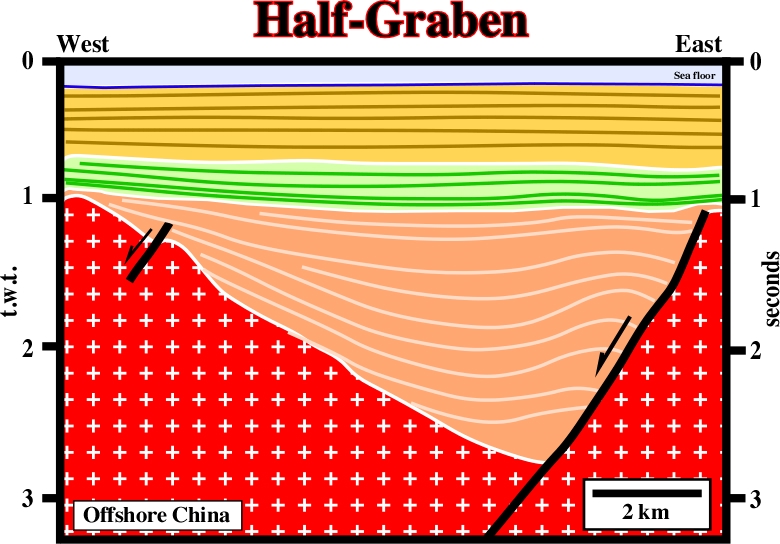
Typical seismic line of China offshore, where the lengthening of the lithosphere created half-graben rift-type basins, in which lacustrine source rocks were deposited. On this particular line, it is interesting to notice that the antiform, recognized on the left part of the half-graben, seems to be the consequence of a lithologic change in the substratum (Paleozoic sediments) rather than a compressional tectonic regime. A change in dip of the fault plane can create a local volume problem obliging the adjacent sediments to lengthen. However, a later reactivation of the bordering normal fault is also possible.

A lot of graben structures can actually be the result of a combination of two half-graben with different vergences and ages. This kind of structure is quite frequent in onshore Sudan, on which this tectonic sketch is based.
Structure analogous to turtle back structure flanked by a single diapir. Synonym of pseudo or apparent turtle back structure.
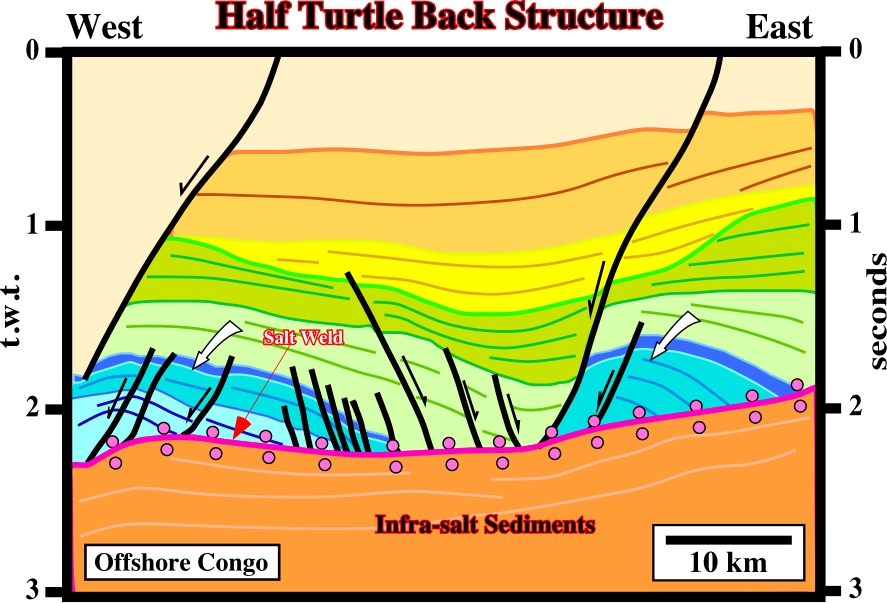
In a turtle back structure, there is always a tectonic inversion. The lower intervals of the overburden thick inward, while the upper intervals thick outward. Such a tectonic inversion, which is induced by salt flowage, creates in the central part large antiforms with a lot of normal faults lengthening the upper intervals. In an half turtle, or pseudo turtle structure, there is no inversion. The antiform is created just by a synsedimentary seaward gliding of the overburden over the salt or salt weld.
A ClNa mineral. Halite is the native salt, occurring in massive, granular, compact, or cubic-crystalline forms, and having a distinctive salty taste.
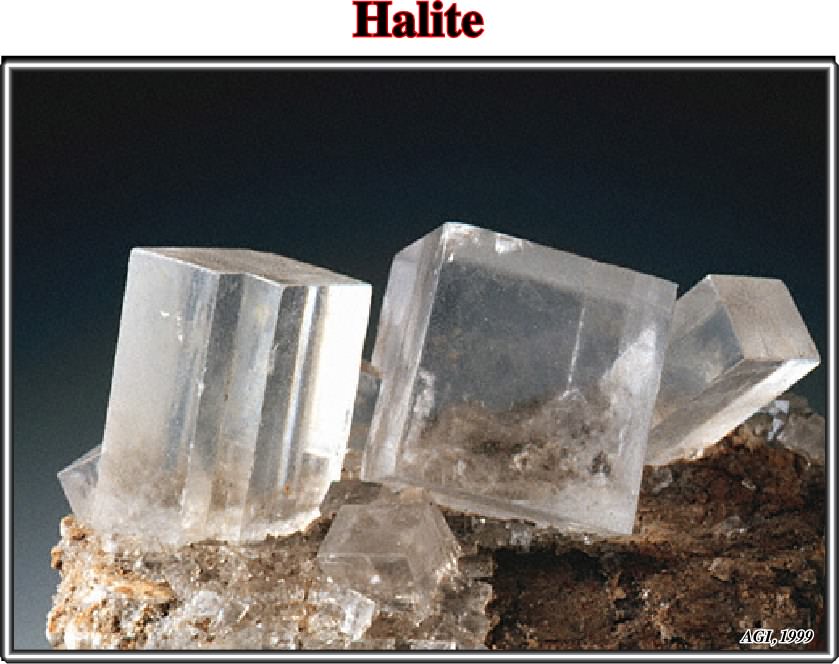
Halite is typically colorless, but certain occurrences provide red, yellow, blue, etc colors owing to impurities and /or color centers in the structure.
Form of salt tectonics in which salt flow is powered buoyancy, that is, by release of gravity potential energy alone, in absence of significant lateral tectonic forces (
t = 0).
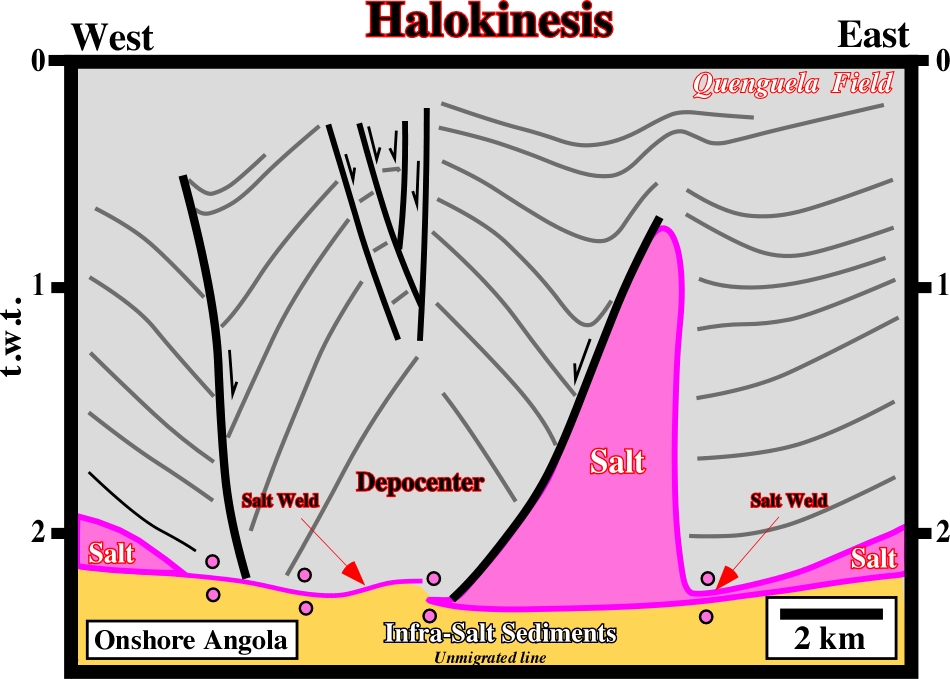
It was in onshore Angola, using data of the quality illustrated by this line, that geologists of Petrangol (Fina) advanced the hypothesis that the structures and thickness variations observed on the ground and on seismic lines, were induced by salt flowage and in absence of a significant tectonic stress (
t). This line is the original line on which the Petrangol's geologist located the successful Quenguela #1, the largest field found so far in onshore Angola (± 40 Mb of reserves).

Two major hypothesis were suggested to explain the Quenguela turtle back structure. The first one, without lengthening of the sediments and in absence of a significant tectonic stress (Halokinesis) was proposed, in the 60s, by Petrangol's geologists. Later, by the end 80s, Total's geologists proposed an hypothesis in which extension and salt flowage contributed to the development of the turtle back. Globally, at the scale of the basin, the Total's hypothesis seems more like. A significant compressional regime counterparting an up-dip extension is obvious on the new regional seismic lines.
Synonym of Halokinesis.
The overlying side of an orebody, fault, or mine working. Presently, and particularly in oil industry hangingwall is used to express the wall rock above an inclined vein or fault.
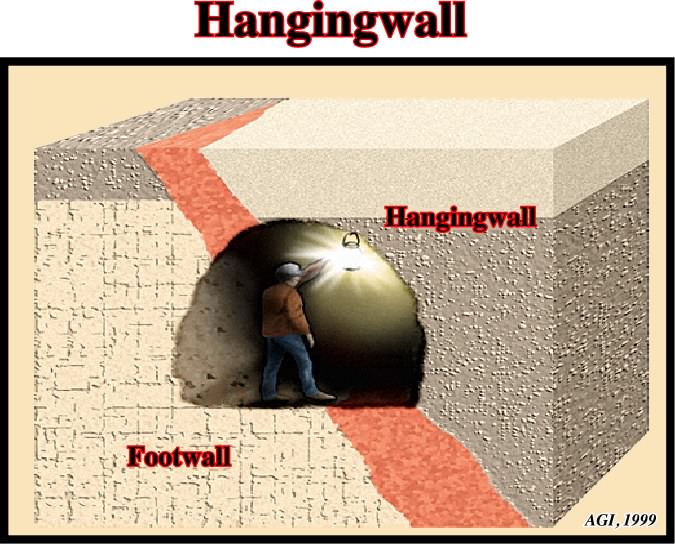
The hangingwall is a synonym of the down-thrown fault block, i.e., the faulted block that has a downward relative movement in relation to the up-thrown block.
See: Inharmonious folding.
Hedreocraton (McNeill, L. et al., 1999)
A stable, continental craton, including both continental shield and platform. Synonym of Thalassocraton and Epeirocraton.
Synonym of fold hinge.
Displacement of aquifers induced by pressure gradients in potential reservoirs. Hydrodynamism can be centripetal or centrifugal. It can enhance, or destroy, the closure of a trap. It enhance the closure when the hydrodynamic flow is in the opposite sense of the migration of the hydrocarbons. Contrariwise, it can destroy the trapping, i.e., when the flow is in the same sense of the migration of the hydrocarbons.
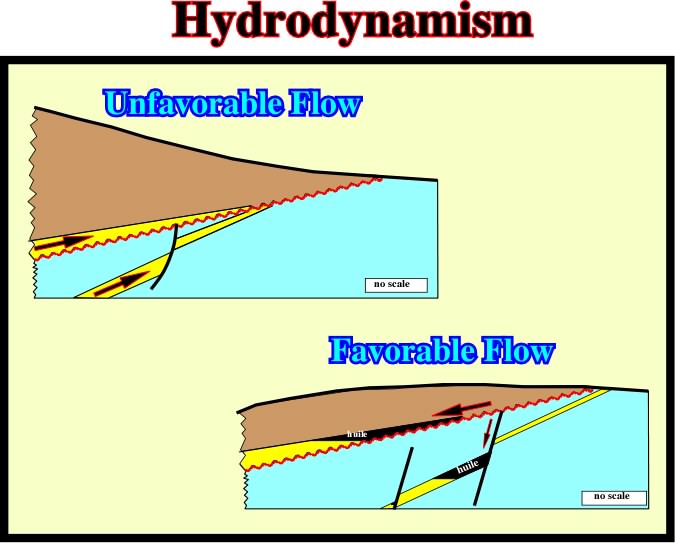
Levorsen (1966) showed an hydrodynamic flow can destroy, or favor, a non-structural trap. Indeed, when the flow is in the sense of hydrocarbon migration, the probability that a non-structural traps accumulate hydrocarbons is quite small. Actually, as several geologists point out, an economical accumulation and particularly, a giant accumulation, are characterized by the presence of three trapping components: (i) structural, (ii) stratigraphic and (iii) hydrodynamic.
Stress that is uniform in all directions, as beneath a homogeneous fluid. It causes dilation rather than distortion in isotropic materials. See: Pore Pressure.
Said of or pertaining to hot water, to the action of the hot water or to the products of this action, such as a mineral deposit precipitated from a hot aqueous solution with or without demonstrable association with igneous processes; also, said of the solution itself. Hydrothermal is generally used for any hot water but has been restricted by sole to water of magmatic origin.